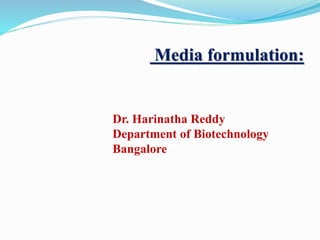
Media formulation, media constituents
- 1. Media formulation: Dr. Harinatha Reddy Department of Biotechnology Bangalore
- 2. To download power point : Pay: 20 US $ or RS : 400 and send pay receipt to mail (biohari14@gmail.com). I will send power point to your mail id. Name: Harinatha Reddy Bank name: HDFC Account number: 50100203661752 IFC code: HDFC0000514 Bangalore Karnataka.
- 3. Medium formulation is done by changing one of independent variables such as nutrients, pH, temperature, etc. by fixing rest of others at specific level. Carbon + Nitrogen source + O2 + Other requirements ----> Biomass + Products + CO2 + H2O+ Heat
- 4. In most cases, the medium is independent of the bioreactor design and process parameters. Even small modifications in the medium could change cell line stability, product quality, yield, operational parameters, and downstream processing
- 5. Media must satisfy all nutritional requirements of the organism. Generally must provide a carbon source (for energy and for biosynthesis) nitrogen, phosphorous and sulfur. Sources of – Macro and Micro (trace) elements. Some require vitamins e.g. biotin and riboflavin. Medium composition:
- 6. Ion Examples of enzymes containing this ion Cupper Cytochrome oxidase Ferrous Catalase Cytochrome Magnesium Glucose 6-phosphatase Hexokinase DNA polymerase Manganese Arginase Molybdenum Nitrate reductase Nitrogenase Nickel Urease Zinc Alcohol dehydrogenase Carbonic anhydrase DNA polymerase
- 7. Essential characteristics of formulated media: Media must satisfy all nutritional requirements of the organism. It should produce the maximum yield of biomass and product. It should also have minimal problems during media designing recovery of desired product.
- 8. The role of trace elements (Iron, Zinc, Copper, Selenium, Manganese & Molybdenum) in medium formulation might be quite significant. The concentration of NaCl is needed to adjust the osmolarity of media and pH is commonly maintained by CO2-bicarbonate system
- 10. Many elements are needed for microorganism nutrition and their physiological functions. Thus, these elements have to be supplied in the culture medium to support adequate growth of microbial cultures. Constituents of media:
- 11. The culture media usually contain the following constituents: 1. Inorganic nutrients 2. Carbon and energy sources 3. Organic supplements 4. Antibiotics 5. Solidifying agents 6. Salts
- 12. 1. Inorganic Nutrients: The inorganic nutrients consist of macronutrients and micronutrients. C, H, O, N, S. P, K, and traces of Fe, Ca, Mn Zn, Co, Cu, and Mo elements are found in the form of inorganic ions in water,
- 13. Macronutrient elements: The six elements namely nitrogen, phosphorus, potassium, calcium, magnesium and sulfur are the essential macronutrients for tissue culture. Micronutrients: Although their requirement is in minute quantities, micronutrients are essential for plant cells and tissues. These include iron, manganese, zinc, boron, copper and molybdenum.
- 14. 2. Carbon and energy sources Majority of culture media contain glucose which serves as an important source of energy. Glucose is degraded in glycolysis to form pyruvate/lactate. These compounds on their further metabolism enter citric acid cycle and get oxidized to CO2 and H2O . .
- 15. 3. Organic supplements: Several additional organic compounds are usually added to the media to support cultures. These include certain proteins, peptides, Vitamins, lipids, nucleosides, serum and citric acid cycle intermediates.
- 16. Serum: Serum is a natural biological fluid, and is rich in various components to support cell proliferation. The most commonly used sera are calf serum (CS), fetal bovine serum (FBS), horse serum and human serum. While using serum, it must be screened for viral diseases (hepatitis B, HIV).
- 17. Vitamins: The medium should be supplemented with vitamins to achieve good growth of cells. The vitamins added to the media include thiamine, riboflavin, niacin, pyridoxine, folic acid, pantothenic acid, biotin, ascorbic acid and vitamin E.
- 18. Amino acids: The media supplemented with amino acids stimulate cell growth and help in establishment of cells lines. Further, organic nitrogen (in the form of amino acids such as L- glutamine, L-asparagine, L- arginine, L-cysteine) is more readily taken up than inorganic nitrogen by the cells.
- 19. 4. Antibiotics Antibiotics were added to reduce contamination. The most commonly used antibiotics were ampicillin, penicillin, gentamycin, erythromycin, kanamycin, neomycin and tetracycline.
- 20. 5. Solidifying agents: For the preparation of semisolid or solid tissue culture media, solidifying or gelling agents are required.
- 21. Agar: Agar, a polysaccharide obtained from seaweeds (Red algae: (Gelidium and Gracilaria) is most commonly used as a gelling agent for the following reasons. It does not react with media constituents. It is not digested by microbial or plant enzymes and is stable at culture temperature. Agar at a concentration of 0.5 to 1% in the medium can form a gel.
- 22. Gelatin: It is used at a high concentration (10%) with a limited success. This is mainly because gelatin melts at low temperature (25- 35°C), and consequently the gelling property is lost.
- 23. 6. Salts: The salts contribute to cations (Na+, K+, Mg2+, Ca2+ etc.) and anions (CI–, HCO– 3, SO2- 4, PO3- 4), and are mainly responsible for the maintenance of solute concentration. Na+, K+ and CI– ions regulate membrane potential. PO3- 4 is required for ATP synthesis.
- 24. Advantage of Salts in Media: Supply essential inorganic ions. Provide requisite pH. Maintain the solute concentration in media.
- 25. THANK YOU………………
